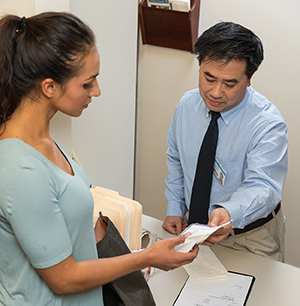Pain Relief Methods for Temporomandibular Disorders (TMD)
You have been diagnosed with temporomandibular disorder (TMD). This term describes a group of problems linked to the temporomandibular joint (TMJ) and nearby jaw muscles. The TMJ is located where the upper and lower jaws meet. TMD can cause painful and frustrating symptoms. Your healthcare provider can advise different pain relief methods as part of your treatment. These may include medicines and certain types of therapy, such as massage or gentle exercise.
Using medicines
Medicines may be prescribed to treat TMD. Other medicines may be available over the counter. The medicine type and dosage will depend on the problem you have. For your safety, tell your healthcare provider if you are currently taking any prescription or over-the-counter medicines, vitamins, herbs, or supplements. Common medicines used to treat TMD include:
-
Anti-inflammatories and analgesics. These treat pain, inflammation, osteoarthritis, and rheumatoid arthritis. Anti-inflammatories reduce swelling, heat, redness, and pain. They also help restore function. Analgesics reduce pain. Nonsteroidal anti-inflammatories (NSAIDs) ease inflammation as well as pain.
-
Muscle relaxants. These treat myofascial pain. This is pain that occurs in the soft tissues or muscles around the TMJ. Muscle relaxants help ease muscle tension that reduces pressure on the TMJ from tight jaw muscles.
-
Antidepressants. These can be used to reduce pain or teeth grinding (bruxism). At higher dosages, these medicines are used to treat depression. Given at low dosages, antidepressants may help ease TMD symptoms. They can reduce muscle pain. They also raise the level of serotonin, a body chemical that improves sleep. This in turn can decrease teeth grinding during the night.

Treating painful muscles
A trigger point is a painful spot in a tight muscle. It is often painful to the touch and may refer pain to other places. Your healthcare provider can focus on trigger points using:
-
Massage. This can be done both inside and outside the mouth. This relaxes muscles and improves circulation.
-
Palpation. This is done by applying pressure to points of the jaw and face with the fingers.
-
Cold spray and stretching of the muscles. This is done to relax the muscles.
-
An anesthetic. This can ease pain. This may be given as an injection by your dentist.
Treating the joint
Therapy may focus directly on the TMJ. There are different ways to treat the joint:
-
A self-care program. This helps you treat and manage symptoms on your own. Your program may include exercises. It may also include using ice and heat to ease pain.
-
Gentle manipulation. This reduces pain and restores range of motion. The healthcare provider uses their hands to relax muscles and ligaments around the joint.
-
Exercises. These strengthen muscles in the jaw and face.
-
Ultrasound. This uses sound waves to reduce pain and swelling.
Treating inflammation
When the joint is inflamed, movement becomes difficult and painful. Your healthcare provider can help. Treatment may include:
-
Rest and gentle exercise. This is done to increase range of motion. One common exercise is to apply pressure to the jaw and resist the movement (isometric exercise).
-
A cold pack. This eases swelling and reduces pain. A cold pack may be applied for 10 to 20 minutes. Repeat 3 or 4 times a day. To make a cold pack, put ice cubes in a plastic bag that seals at the top. Wrap the bag in a clean, thin towel or cloth. Never put ice or a cold pack directly on the skin.
-
Massage and gentle manipulation. As described above.
Online Medical Reviewer:
Jessica Gotwals RN BSN MPH
Online Medical Reviewer:
Michael Kapner MD
Online Medical Reviewer:
Rita Sather RN
Date Last Reviewed:
12/1/2022
© 2000-2024 The StayWell Company, LLC. All rights reserved. This information is not intended as a substitute for professional medical care. Always follow your healthcare professional's instructions.